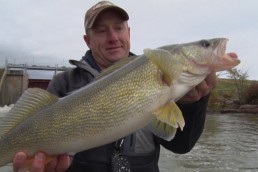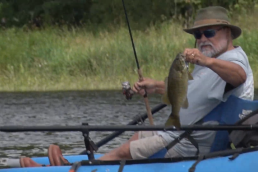Summertime, and the River is Easy…and Shallow
SHARE THIS POST
Classic smallmouth rivers tend to have cool water, sandy bottoms with areas of rock and boulders, plenty of fallen trees and logs, and areas of deeper water—like 10 to 12 feet—at river bends. There are loads of fishy-looking places to cast the day away, keeping in mind several important factors:
1)During high water, bass tend to tuck up tight to shore, under fallen trees and logs.
2) During low water, they tend to move out to the center of the river, relating to current breaks around boulders and midriver shoals.
3)With care, you can run up and down them in modest-sized boats under most conditions, except during periods of very low water.
4) You can bring all of your rods, tackle and gear, and experiment with pretty much everything you want.
Got all that? Now, guess what? We’re going to take away your usual boat, restrict your access and limit your options—and in the end, you’ll thank us for it. Because we’re now talking about smaller, shallower river sections, and perhaps even small tributaries to larger smallmouth rivers. Places you probably haven’t fished because you didn’t want to whack your prop, or you just didn’t think they were big and deep enough to be worth fishing. Guess again!
Extremely shallow sections
It’s tempting to say that long, extremely shallow river stretches will tend to hold few gamefish, since gamefish tend to avoid them in favor of sections with deeper water. That may be true in fall and winter, when large fish evacuate shallow stretches in favor of safer places to spend the winter, rather than being trapped in ice. But let’s pause on that advice for smallmouths, at least for the summer season. The fact is, smallmouths may indeed inhabit miles of river where sandy bottom seldom exceeds much more than three feet in depth.
There will, of course, be river bends where deeper holes are swept out by current, plus an assortment of ripples and rapids where smallies set up along current breaks in pretty typical fashion. But there’s more to it than that.
In small, shallow rivers cool enough to support smallmouths during the warm summer months, shoreline cover is prime habitat. Stretches with numerous fallen trees create enough shady cover to hold bass, even though there’s little to no deep water for long distances. You can toss a lure into the pocket of shade along shore and have a bass or two follow your lure all the way out to the boat. The edges of bulrush beds swept by current, creating a quick drop-off to maybe 4 feet of water at most, may hold smallmouths here and there. So, the point is, there are likely river stretches somewhere near you that most anglers ignore during summer, because they simply look too shallow to hold decent fish.
Getting to those fish, however, requires some adjustment and gyrations, since these stretches may be too shallow to run a typical outboard motor. Knowledgeable river rats opt for jon boats with jet drive outboards that allow them to run miles upriver through shallow sand, dodging occasional logs and rocks, jumping shallow sandbars as they go. Then they spend the day floating back down to the boat launch, casting to the shorelines.
Another option is to just plain drift the river with a shallow-draft craft, putting in at point A, and taking out at point B, miles downstream. This requires some coordination, likely involving at least two anglers and two cars, one left at each location for the day.
Are you enjoying this post?
You can be among the first to get the latest info on where to go, what to use and how to use it!
Canoes are the obvious choice here, and you may, in fact, be able to rent them from a canoe livery and avoid the transportation coordination hassle altogether. You might even find a guide who uses a drift boat, drifting downstream like they do for trout in western rivers.
More and more, anglers are bringing their own inflatable, one-man pontoons to trout rivers, and doing a drift on their own. The same process works with smallmouth rivers. You sit up high above the water on a comfy seat and use a pair of oars to maneuver around fallen trees, moving from one side of the river to the next as you bob happily along.
Where to start
Wear old tennis shoes or wading boots, and perhaps even stop and fish on foot from time to time. Drag your boat onto shallow sand or rock, or onto shore. Bring a rope to tie off on limbs or logs, and maybe tie a rock to the end of a rope to act as an anchor.
Find a bridge, park or some form of access upstream, put in, and float down to a take-out point. If there’s no obvious river access, knock on doors, flash your baby blues, and try to make a new friend who’ll let you use his shoreline as a drop-off point. Bring them some doughnuts, or perhaps offer them a double sawbuck. Just don’t tear up their lawn, dirt road or field if you want to come back again.
The point is, you can access virtually unfished sections of smallmouth rivers with a little creative effort. Bring along a lifejacket, sunscreen, insect repellent, a small cooler with snacks and drinks, a couple of rods, a few lures, and put your phone or camera in a waterproof bag, or at least a ZipLoc. Polarized sunglasses and a hat are essential. Consider a small landing net, although you can usually just land bass by hand.
Once you push offshore, you’re suddenly in a quiet setting, floating gently downstream. It’s an oddly peaceful sensation, like being in a hot air balloon. You cast this shore, move over to that shore, be sure to hit those shady trees, and lay a few casts out where rocks create a noticeable bulge on the surface as water flows over them. No hurry. No worry.
For lures, keep it simple, but do have options, since smallies can be fussy at times. You need a couple of topwaters for sure. I like propeller baits; you may prefer poppers. Speaking of poppers, a fly rod with your favorite popping bug is right on target. When fish don’t want to rise to the occasion, try a subsurface lure like a #10 X-Rap. Maybe toss in a couple of tandem spinnerbaits for throwing deeper into log jams. I suggest rigging a few 5-inch soft plastic minnows Texas-style, with no weight; you can drift them right into log jams and under algae mats, and most of the time, get both your lure and your hooked fish back out.
Heck, sometimes fish follow you as you drift downriver, trailing a topwater behind the boat as you much on a sandwich or granola bar. Sploosh! They grab your lure, even though you’re ignoring them at the moment. Hey, they all count.
Become a MidWest Outdoors Insider here!
MWO
SHARE THIS POST
Did you enjoy this post?
You can be among the first to get the latest info on where to go, what to use and how to use it!
Dave Csanda
Dave Csanda has enjoyed 40 years in the fishing communications industry at In-Fisherman, Angling Edge and now, as editor of MidWest Outdoors. He is an inductee of both the Minnesota and National Fresh Water Fishing Halls of Fame.



